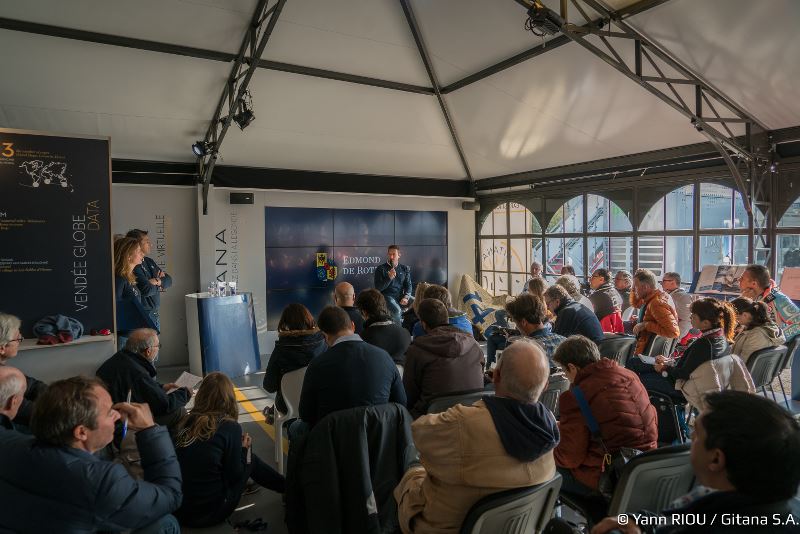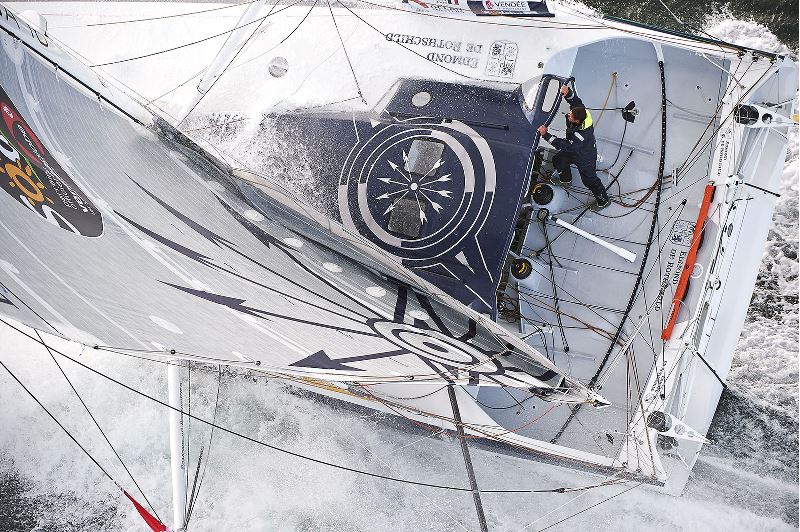
What does this race represent today: “The Vendée Globe is a slice of life. When you’re lucky enough to prepare for such an event, it’s a strong commitment for the whole team. It has an influence on our lives for several years. In the Gitana Team, we’ve long been obsessed by this date of 6 November.”
The evolution of the boats since his first Vendée Globe: “In 2004, my boat VMI was naturally light years away from Edmond Rothschild. There was 4.5 tonnes of water in the ballast tanks. We peaked at 20 knots, whilst now we race at in excess of 30.”
The on-board discomfort: “Above all you have to just get used to it because the way the boat handles has changed, but like anything, with time, you suffer less and you gain confidence.”
Controlling your machine: “On flat seas and with medium to medium ‘plus’ conditions, I can fully control Edmond de Rothschild but with the foils at sea, I think we’re operating more at 80%. And if the boat is really being thrown around excessively, we can depower her by immersing the foil and unloading the ballast tanks.”
The possible increase in bodily risks on the foilers: “ If we look back to the accidents suffered by Yann Eliès (Vendée Globe 2008) and Paul Meilhat (Transat St Barth – Port la Forêt 2015), that was on boats with classic straight daggerboards. We also have all the highly protected cockpits and as long as we’re on them we are nice and secure nevertheless.”
The change of references aboard foilers: “We’re getting closer and closer to multihulls, with the sails further apart and slimmer profiles. We also aim to sail with them as flat as possible, which is when the boat makes the fastest headway.”
The exclusion zone in the Deep South in terms of linked to the presence of icebergs: “This has existed since 2004, but the way of delimiting this zone has evolved over time. In 2012, it was gates that had to be passed through and the competitors were able to dive south between each of them. Here, it’s a continuous line not to be crossed. However, before that, the gates were further North than the current line so ultimately it doesn’t change much.”
Weather conditions at the race start set to favour the foilers: “We’re expecting a N’ly wind that will clock round to the NE, enabling the boats to slip along downwind in a well sustained medium breeze, which it’s true to say is favourable for the foilers, unless they have to bear away a bit more. In the latter case, the non-foilers will be just as much at ease. We could be level with the Canaries in three days, which is quick. The question of what pace to set from the start will depend on each boat. The Vendée Globe isn’t won by being the first to the Doldrums, and even less so if you break the boat before you get there. As such, you essentially need to manage to settle into your own rhythm.”
Race predictions: “I don’t attach a great deal of importance to the forecasts as the Vendée Globe writes its own law. Back in 2008, Armel (Le Cléac’h) finished 2nd after previously having a deficit of up to 1,000 miles. You can never know what will happen and, when you’re going through it, you only really get a grasp of that then.”
The place he fears the most on the course: “The Bay of Biscay, both on the outward and inward crossing. You can finish with 60 knots of breeze and a formidable swell off Cape Finisterre as you hit the continental shelf. The Vendée Globe isn’t over until the finish line is crossed.”
The drama of the canal on Sunday: “Inevitably it’s a bit of a controlled emotion. You have tears in your eyes, a lump in your throat and a stomach in knots as you’re heading off for such a long time… The public is out in force, to cheer us on; it’s fantastic. At the same time, you know that a few minutes later, you’ll be at sea, shortly before the start, with a lot of boats around us. As such, me and the team have to stay focused.”

